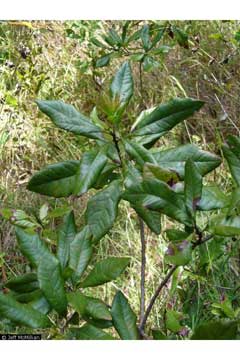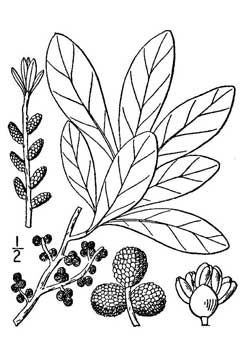 |
|
Jeff McMillian @ USDA-NRCS PLANTS Database |
 |
| USDA-NRCS PLANTS Database / Britton, N.L., and A. Brown. 1913. An illustrated flora of the northern United States, Canada and the British Possessions. 3 vols. Charles Scribner's Sons, New York. Vol. 1 |
Translate this page:
Summary
Physical Characteristics

 Myrica heterophylla is an evergreen Shrub growing to 3 m (9ft 10in).
Myrica heterophylla is an evergreen Shrub growing to 3 m (9ft 10in).
See above for USDA hardiness. It is hardy to UK zone 6. It is in leaf all year, in flower in May, and the seeds ripen in September. The species is dioecious (individual flowers are either male or female, but only one sex is to be found on any one plant so both male and female plants must be grown if seed is required). and is pollinated by Wind. The plant is not self-fertile.
It can fix Nitrogen.
Suitable for: light (sandy), medium (loamy) and heavy (clay) soils and prefers well-drained soil. Suitable pH: mildly acid, neutral and basic (mildly alkaline) soils. It can grow in semi-shade (light woodland) or no shade. It prefers dry or moist soil. The plant can tolerate maritime exposure.
UK Hardiness Map
US Hardiness Map
Synonyms
Plant Habitats
Woodland Garden Sunny Edge; Dappled Shade; Hedge;
Edible Uses
Edible Parts: Fruit
Edible Uses: Condiment Tea
The following notes are for the closely related M. cerifera. It is assumed that they also apply to this species[K]. Fruit - raw or cooked[105, 177, 183]. The fruit is about 2 - 4mm in diameter with a single large seed[200]. There is very little edible flesh and this is of poor quality[K]. Leaves and berries are used as a food flavouring[62, 105, 177]. An attractive and agreeable substitute for bay leaves, used in flavouring soups, stews etc[183]. The dried leaves are brewed into a robust tea[183].
References More on Edible Uses
Medicinal Uses
Plants For A Future can not take any responsibility for any adverse effects from the use of plants. Always seek advice from a professional before using a plant medicinally.
Astringent Dysentery Emetic Stimulant Tonic
The following notes are for the closely related M. cerifera. It is assumed that they also apply to this species[K]. The root bark is astringent, emetic (in large doses), sternutatory, stimulant and tonic[4, 21, 46, 165, 213]. It is harvested in the autumn, thoroughly dried then powdered and kept in a dark place in an airtight container[4]. It is used internally in the treatment of diarrhoea, jaundice, fevers, colds, influenza, catarrh, excessive menstruation, vaginal discharge etc[4, 238]. Externally, it is applied to indolent ulcers, sore throats, sores, itching skin conditions, dandruff etc[4, 238]. The wax is astringent and slightly narcotic[4]. It is regarded as a sure cure for dysentery and is also used to treat internal ulcers[4]. A tea made from the leaves is used in the treatment of fevers and externally as a wash for itchy skin[222].
References More on Medicinal Uses
The Bookshop: Edible Plant Books
Our Latest books on Perennial Plants For Food Forests and Permaculture Gardens in paperback or digital formats.

Edible Tropical Plants
Food Forest Plants for Hotter Conditions: 250+ Plants For Tropical Food Forests & Permaculture Gardens.
More

Edible Temperate Plants
Plants for Your Food Forest: 500 Plants for Temperate Food Forests & Permaculture Gardens.
More

More Books
PFAF have eight books available in paperback and digital formats. Browse the shop for more information.
Shop Now
Other Uses
Dye Hedge Hedge Wax Wood
The following notes are for the closely related M. cerifera. It is assumed that they also apply to this species[K]. A wax covering on the fruit is extracted by scalding the fruit with boiling water and immersing them for a few minutes, the wax floats to the surface and is then skimmed off. The fruit is then boiled in water to extract the wax from the pulp and once more the wax is skimmed off. It is then strained through a muslin cloth and can be used to make aromatic candles, sealing wax etc[1, 4, 6, 11, 62, 95, 171, 245]. Candles made from this wax are quite brittle but are less greasy in warm weather[213]. They are slightly aromatic, with a pleasant balsamic odour[245], and do not smoke when put out, making them much more pleasant to use that wax or tallow candles[213]. The wax is also used in making soaps[213]. About 1 kilo of wax can be obtained from 4 kilos of berries[4]. A blue dye is obtained from the fruit[6]. The plant can be grown as an informal hedge[200], succeeding in windy sites[K]. Wood - light, soft, brittle, fine-grained[82, 227]. The wood weighs 35lb per cubic foot[227]. It is of no commercial value[229].
Special Uses
Hedge Hedge Nitrogen Fixer
References More on Other Uses
Cultivation details
Prefers a moist soil[200]. Grows well in an open position in a well-drained soil in sun or light shade[200]. Thrives in any ordinary garden soil according to one report[11] whilst another says that it thrives in an acid soil[182]. Prefers a lime-free loamy or peaty soil[1]. Succeeds in dry and maritime climates[200]. Closely related to M. pensylvanica and M. cerifera[200]. Dioecious, male and female plants must be grown if seed is required. Plants in this genus are notably resistant to honey fungus[200]. Many species in this genus have a symbiotic relationship with certain soil micro-organisms, these form nodules on the roots of the plants and fix atmospheric nitrogen. Some of this nitrogen is utilized by the growing plant but some can also be used by other plants growing nearby[200].
References Carbon Farming Information and Carbon Sequestration Information
Temperature Converter
Type a value in the Celsius field to convert the value to Fahrenheit:
Fahrenheit:
The PFAF Bookshop
Plants For A Future have a number of books available in paperback and digital form. Book titles include Edible Plants, Edible Perennials, Edible Trees,Edible Shrubs, Woodland Gardening, and Temperate Food Forest Plants. Our new book is Food Forest Plants For Hotter Conditions (Tropical and Sub-Tropical).
Shop Now
Plant Propagation
Seed - best sown as soon as it is ripe in the autumn in a cold frame[78]. Stored seed germinates more freely if given a 3 month cold stratification and then sown in a cold frame[78]. Germination is usually good[78]. Prick out the seedlings into individual pots when they are large enough to handle and grow on in a cold frame for the first winter. Plant out in late spring or early summer[K]. Cuttings of half-ripe wood, 5 - 8cm with a heel, July/August in a frame. Pot up and overwinter in a cold frame then plant out in late spring or early summer. Fair to good percentage[78]. Layering in spring[200].
Other Names
If available other names are mentioned here
Native Range
NORTHERN AMERICA: Canada (Québec (southwest), Nova Scotia, Ontario, New Brunswick, British Columbia (south)), United States (Connecticut, Indiana, Maine, Massachusetts, Michigan, New Hampshire, New Jersey, New York, Ohio, Pennsylvania, Rhode Island, Vermont, West Virginia, Iowa, Kansas, Minnesota, Missouri, Nebraska, Illinois, Oklahoma, Wisconsin, Montana, Oregon, Washington, Alabama, Arkansas, Delaware, Florida, Georgia, Kentucky, Louisiana, Maryland, Mississippi, North Carolina, South Carolina, Tennessee, Virginia, New Mexico, Texas, Arizona, California), Mexico (Ciudad de México, Jalisco, Michoacán de Ocampo, Veracruz de Ignacio de la Llave)
Weed Potential
Right plant wrong place. We are currently updating this section.
Please note that a plant may be invasive in one area but may not in your area so it's worth checking.
Conservation Status
IUCN Red List of Threatened Plants Status :

Growth: S = slow M = medium F = fast. Soil: L = light (sandy) M = medium H = heavy (clay). pH: A = acid N = neutral B = basic (alkaline). Shade: F = full shade S = semi-shade N = no shade. Moisture: D = dry M = Moist We = wet Wa = water.
Now available:
Food Forest Plants for Mediterranean Conditions
350+ Perennial Plants For Mediterranean and Drier Food Forests and Permaculture Gardens.
[Paperback and eBook]
This is the third in Plants For A Future's series of plant guides for food forests tailored to
specific climate zones. Following volumes on temperate and tropical ecosystems, this book focuses
on species suited to Mediterranean conditions—regions with hot, dry summers and cool, wet winters,
often facing the added challenge of climate change.
Read More
Expert comment
Author
Raf.
Botanical References
200229270
Links / References
For a list of references used on this page please go here
Readers comment
| Add a comment |
|
If you have important information about this plant that may help other users please add a comment or link below. Only comments or links that are felt to be directly relevant to a plant will be included. If you think a comment/link or information contained on this page is inaccurate or misleading we would welcome your feedback at [email protected]. If you have questions about a plant please use the Forum on this website as we do not have the resources to answer questions ourselves.
* Please note: the comments by website users are not necessarily those held by PFAF and may give misleading or inaccurate information.
To leave a comment please Register or login here All comments need to be approved so will not appear immediately.
|
Subject : Myrica heterophylla
|
|
|
|